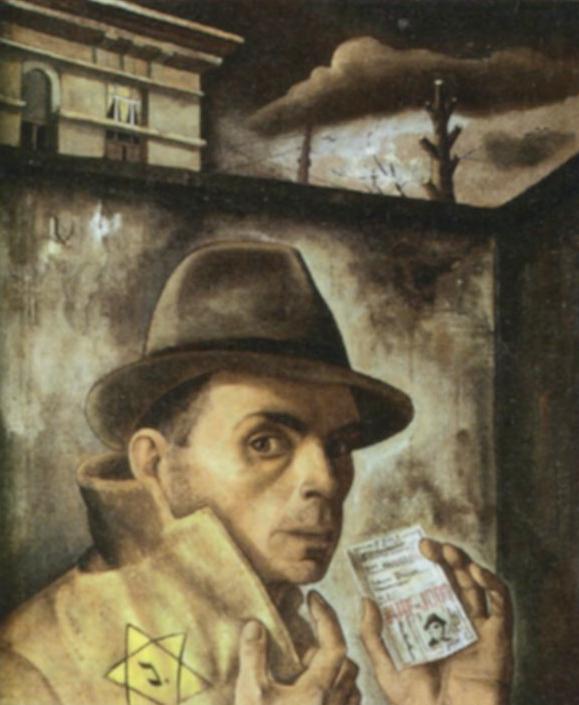
NAZI Art: Individual Artists

Figure 1.--With Hitler'seizure of power, German artistsnd other cultural figures were left with stark choices: exile, inner, exile, or accomodation. The vast majority of German artists chose accomodation. A brave few took the very dangerous alternative of using their art to oppose the NAZIs. This proved impossible in Germany, but was conducted in exike from other countries. Many of these countries during the War were occupied by the Germans putting the artists in mortal jepoardy. Felix Nussbaum, a Jew hiding in Belgium, painted works depicting the suffering of the Jewish people, although not fully understanding what happened after transport. This work was entitled 'Jewish Pass' and painted about 1943. He and his wife were arested and nurdered in Auschwitz (1944).
|
|
German artists basically had three alternatives: exile, inner emigration, or accomodation. Many artists chose exile as working under such conditions was intolerable for them. This included some of the most important of the Weimar artits. Paul Klee left for Switzerland. Wassily Kandinsky went to Paris. Oskar Kokoschka left for England. Grosz emigrated to the United States of America. They had all been identified as 'purveyors of non-German art'. Most German artists rejected exile and chose instead accomodation. This included not only artists, but also architects, composers and musicins, film directors and actors, painters, writers, and others. It is of course easy to condemn today. How we would have acted in similar circumstances is a very different matter. One gets the impression today, that Hollywood's embrace of PC thought is party the deire to allign themselves with the currents most condusive for their career. One author asks the question, "What are we to make of those cultural figures, many with significant international reputations, who tried to find accommodation with the Nazi regime?” [Petropoulos] The author explains how individuals variously dealt with the NAZIs dictates on art, especially their opposition to modern art. It is nor entirely true that all modern artists were anti-NAZI and all NAZIs anti-modernist. Most like Emil Nolde chose accomdation. Others embraced the NAZIs. A brave few took the very dangerous alternative of using their art to oppose the NAZIs. This proved impossible in Germany, but was conducted in exike from other countries. Max Beckmann in the occupied Netherlands painted allegories of NAZI brutality. Felix Nussbaum, a Jew hiding in Belgium, painted works depicting the suffering of the Jewish people, although not fully understanding what happened after transport and thus not depicting it. He anbd his wife were murdered in Auschwitz (1944). John Heartfeld (Helmut Herzfelde) attempt to resist in Berlin, but had to go into exile in Prague. He produced photo images depicting NAZI depravity and incompetence. [Keel] Many of these countries during the War were occupied by the Germans putting the artists in mortal jepoardy.
Source
Keel, Erich. "Artists against the Third Reich," Smithsonian Association Course (October 28, 2015).
Petropoulos, Jonathan. Artists Under Hitler: Collaboration and Survival in Nazi Germany (2014).
CIH -- WW II

Navigate the CIH World War II Section:
[Return to Main NAZI art page]
[Return to NAZI Revolution: Government]
[Return to Main NAZI Government: Revolution page]
[Return to Main NAZI government page]
[Return to Main NAZI page]
[Return to Main World War II page]
[About Us]
[Biographies]
[Campaigns]
[Children]
[Countries]
[Deciding factors]
[Diplomacy]
[Geo-political crisis]
[Economics]
[Home front]
[Intelligence]
[POWs]
[Resistance]
[Race]
[Refugees]
[Technology]
[Totalitarian powers]
[Bibliographies]
[Contributions]
[FAQs]
[Images]
[Links]
[Registration]
[Tools]
[Return to Main World War II page]
[Return to Main war essay page]
[Return to CIH Home page]
Created: 6:13 PM 8/1/2015
Last updated: 5:40 AM 10/4/2015



